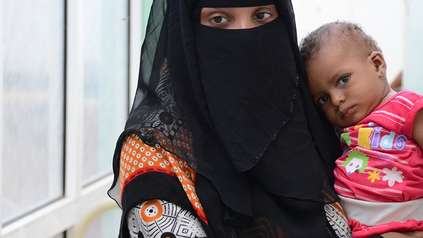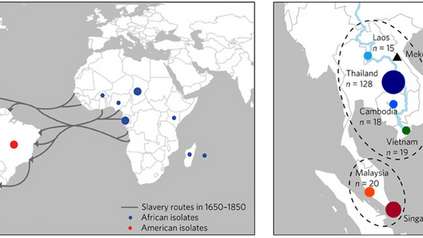Improving global surveillance of antibiotic resistance
A new Technical Note from the World Health Organization (WHO) has been released to help countries worldwide improve their capacities to monitor antimicrobial resistance by using molecular tests. The Technical Note explains the value of using molecular diagnostic methods for surveillance and outlines the infrastructure and technological capabilities required. This information will enable health authorities to make informed choices on the most appropriate molecular tests in order to achieve a clearer picture of antimicrobial resistance globally.
Antimicrobial resistance (AMR) is a global health problem, with resistance to common antibiotics found in all regions of the world. This means it can be extremely difficult to treat some bacterial diseases such as MRSA, tuberculosis and gonorrhoea. Effective antibiotics are also essential for many medical procedures including routine surgery, emergency operations, transplants, and chemotherapy. The threat of infections with bacteria that are resistant to the last-line antibiotics is rising and this could lead to deaths from even minor infections in the future.
As part of a range of measures to address AMR, the WHO Global Antimicrobial Resistance Surveillance System (GLASS) was launched in 2015. Countries worldwide have joined GLASS, establishing national surveillance systems that can monitor antibiotic-resistant bacteria to help understand resistance trends and inform treatment guidelines. GLASS currently relies on tests that measure how bacteria respond to the presence of specific antibiotics, which gives limited information.
This Technical Note was developed by GLASS in collaboration with the WHO AMR Surveillance and Quality Assessment Collaborating Centres Network and partners. Researchers at the Centre for Genomic Pathogen Surveillance, based at the Wellcome Sanger Institute, were commissioned by the WHO to draft the Technical Note under the guidance of the Heads of WHO Collaborating Centres namely, Professor Neil Woodford (WHO Collaborating Centre for Reference and Research on Antimicrobial Resistance and Healthcare Associated Infections, UK), Professor Monica Lahra (WHO Collaborating Centre for Sexually Transmitted Diseases, Australia), and Professor Roman Kozlov (WHO Collaborating Centre for Capacity Building on Antimicrobial Resistance Surveillance and Research, Russia). This Technical Note will be especially helpful for countries that are just starting to use molecular technologies and will stand to benefit from the utility of these new methods.
The WHO Technical Note details how molecular diagnostic tests using DNA or proteins can give reliable data that can complement current methods. The Technical Note considers three different laboratory contexts, each with different levels of capacities for molecular AMR testing: those with no prior experience in molecular AMR surveillance; newly established national reference laboratories (NRLs); and fully established NRLs with experience in molecular AMR surveillance.
The Technical Note details the advantages and limitations of existing molecular methods for the different types of laboratories and their cost effectiveness, providing a landscape analysis to assist decision making.
“We were delighted to be involved in the development of this WHO technical note on how to use molecular methods for AMR surveillance. Our contribution to this technical note has been informed by our strong international partnerships with public health surveillance teams across the world and builds on our establishment of the NIHR Global Health Research Unit last year. We hope this will have a significant impact on informed choices that different laboratories and countries may make to improve AMR surveillance.”
Professor David Aanensenfrom the Centre for Genomic Pathogen Surveillance (CGPS) at the Wellcome Sanger Institute and Big Data Institute, University of Oxford
“Tracking the emergence and transmission of superbugs is incredibly difficult and quite patchy. Using innovative technologies such as sequencing will help to fill some of these gaps and deliver much better data on drug resistance around the world. As with all technologies, we will have to work through the hurdles of how it is implemented, but it’s fantastic to see the Wellcome Sanger Institute and WHO collaborating to strengthen the global surveillance system and help deliver countries’ national action plans.”
Ghada Zoubiane Science and innovation lead for Wellcome’s drug-resistant infections programme
The report was funded by the WHO as part of a global effort to improve surveillance of antimicrobial resistance across the globe.
“Urgent action is needed to combat antimicrobial resistance to prevent a post-antibiotic era, where common infections and minor injuries can be fatal. This real threat to global health needs worldwide cooperation to detect and track drug resistant bacteria. Using molecular diagnostics is a new paradigm in disease control which will inform public health decisions and drive regional, national and global action.”
Dr Carmem Pessoa Da Silva from the World Health Organization
More information
Publication:
Molecular methods for antimicrobial resistance (AMR) diagnostics to enhance the Global Antimicrobial Resistance Surveillance System. http://www.who.int/entity/glass/resources/publications/molecular-methods-for-amr-diagnostics/en/
About the Global Antimicrobial Resistance Surveillance System (GLASS):
Launched in October 2015, the Global Antimicrobial Resistance Surveillance System (GLASS) is being developed to support the global action plan on antimicrobial resistance. The aim is to support global surveillance and research in order to strengthen the evidence base on antimicrobial resistance (AMR) and help informing decision-making and drive national, regional, and global actions.
Visit our website: www.who.int/glass
Selected websites
The World Health Organization
The World Health Organization provides global leadership in public health within the United Nations system. Founded in 1948, WHO works with 194 Member States, across six regions and from more than 150 offices, to promote health, keep the world safe and serve the vulnerable. Our goal for 2019-2023 is to ensure that a billion more people have universal health coverage, to protect a billion more people from health emergencies, and provide a further billion people with better health and wellbeing.
Visit our website: www.who.int
The WHO AMR Surveillance and Quality Assessment Collaborating Centres
The WHO AMR Surveillance and Quality Assessment Collaborating Centres aims to support AMR surveillance and quality assessment in each WHO region. WHO Collaborating Centres have been nominated on the basis of their on-going cooperation with WHO to fulfil the requirements of the World health Assembly resolution WHA68.7.
Visit our website https://www.who.int/glass/collaborating-centres-network/en/
The Centre for Genomic Pathogen Surveillance
The Centre for Genomic Pathogen Surveillance is an initiative based at The Wellcome Genome Campus focussed on genomic epidemiology, laboratory and software engineering for global surveillance of microbial pathogens. The Centre seeks to provide genomic and epidemiological big data and tools to allow researchers, doctors and governments worldwide to track and analyse the spread of pathogens and antimicrobial resistance.
The NIHR Global Health Research Unit of Genomic Surveillance of Antimicrobial Resistance
The NIHR Global Health Research Unit on Genomic Surveillance of AMR is focussed on capacity building for genomic surveillance in Low and Middle Income Countries. Capacity in Laboratory, Bioinformatics and Financial management within The Phillipines, Nigeria, Colombia and India is driven by National Units linked to networks or participating hospitals and laboratories. Through large scale sequencing, training and delivery of open data through web resources, data are being generated to understand the population structure and monitoring of important species driving the spread of antimicrobial resistance.
The Big Data Institute
The Big Data Institute is located in the Li Ka Shing Centre for Health Informatics and Discovery at the University of Oxford. It is an interdisciplinary research centre that focuses on the analysis of large, complex data sets for research into the causes, consequences, prevention and treatment of disease. Research is conducted in areas such as genomics, population health, infectious disease surveillance and the development of new analytic methods. The Big Data Institute is supported by funding from the Medical Research Council, the UK Research Partnership Investment Fund, the National Institute for Health Research Oxford Biomedical Research Centre, and philanthropic donations from the Li Ka Shing and Robertson Foundations.
Further details are available at www.bdi.ox.ac.uk
Wellcome Sanger Institute
The Wellcome Sanger Institute is one of the world’s leading genome centres.
Through its ability to conduct research at scale, it is able to engage in bold and long-term exploratory projects that are designed to influence and empower medical science globally. Institute research findings, generated through its own research programmes and through its leading role in international consortia, are being used to develop new diagnostics and treatments for human disease.
Find out more at www.sanger.ac.uk or follow @sangerinstitute on Twitter, Facebook, LinkedIn and on our Blog.
Wellcome
Wellcome exists to improve health for everyone by helping great ideas to thrive. We’re a global charitable foundation, both politically and financially independent. We support scientists and researchers, take on big problems, fuel imaginations and spark debate.





